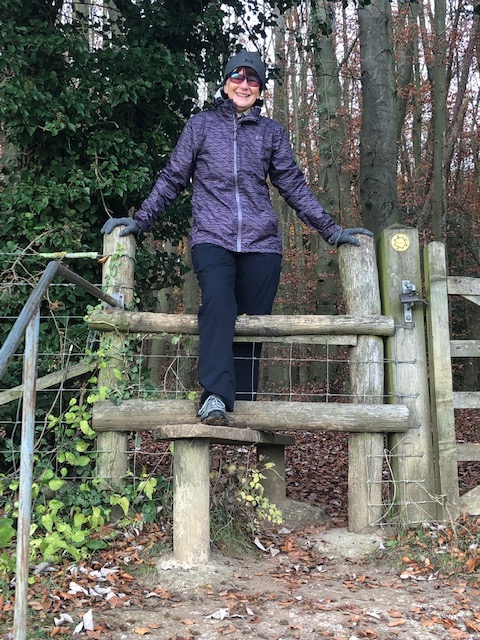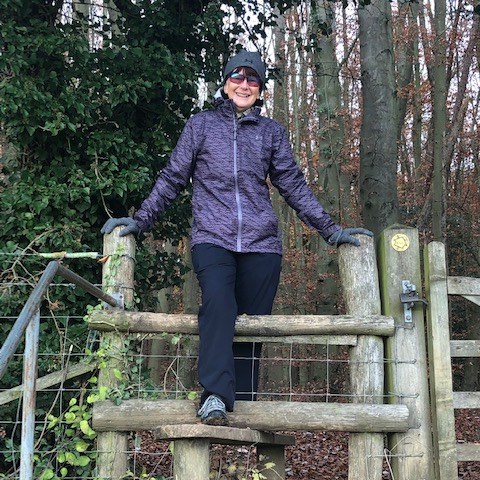Angela’s custom-made knee replacement
Custom-made knee replacement surgery
After several years discussing options and timing with Ian McDermott, in the summer of 2021 I decided to proceed with the replacement of my right knee with a new customised Conformis knee. I am sure there are many things that determine the success of a knee replacement surgery, not least of which is the choice of surgeon and timing, but I just wanted to put on paper some of the things that really stood out to me as the patient.
Once you have made the decision to move forward with the procedure, read everything that Ian sends to you, then read it again and make sure someone close to you reads it as well! There is so much great advice contained in the various papers, some of which you only appreciate after the surgery, so read it again when you get home from hospital.
It is no surprise that the stronger you are before surgery, then the better prepared you will be for the procedure and particularly for the post-surgical rehabilitation and recovery afterwards. Whilst I had always been active and sporting throughout my life, my knee meant limitations in recent times, so I made sure I continued to do whatever I could in the time leading up to surgery within the restrictions imposed by my knee. However, I appreciate not everyone will be physically able to do this, and it’s best to discuss individual circumstances with the consultant.
I was well cared for by the surgical, nursing, rehab, and welfare team during my time in hospital. Unfortunately, I found that the effects of the medication and anesthetic meant I couldn’t make best use of the initial physiotherapy available to me in hospital, but they visited me regularly and helped me using my crutches around the corridors and down the stairs. They also provided a sheet of exercises to continue when I returned home, which I am still using most days, four months later.
Don’t get too down if you are not feeling up to getting as much benefit from the initial physiotherapy as you had hoped, but do make sure you understand the exercises you will need to do once back home before you are discharged.
I arranged to hire the Game Ready chilled water/compression device, and this was delivered to the hospital prior to my arrival. So, with the help of the nurses, I was able to start using this whilst in the hospital. I continued to use it daily after returning home and believe it really helped, particularly with reducing the swelling. I kept the Game Ready for 8 weeks after surgery, but would recommend keeping for at least 4 weeks.
Aside from the skill and advice of the surgical team, to my mind the key factor in recovery is rehabilitation. This may seem obvious, but I cannot emphasise enough: the more effort you make, the better the result. Firstly, make sure arrangements are in place for rehabilitation well before the day of the surgery. I had a trusted osteopath (doesn’t have to be a Physiotherapist) who I had worked with previously, and I immediately scheduled appointments in with him starting just 3 days after leaving hospital (and 5 days after the surgery). This benefitted me in so many ways, not just getting the physical help with my rehabilitation but meeting regularly with someone knowledgeable who could answer questions and to give me confidence and reassurance. Surgery is very much the first stage of making the most of your new knee but, it is crucial for you to continue with your exercises at home every day and regularly meet with your osteopath or physio who will help you make the best possible recovery. I was fortunate to have two sessions a week for the first 8 weeks after surgery, and then continued once a week for a further 4 weeks. Remember, you will need someone to transport you to rehab in the earlier stages.
Now for the really important part – Rehab Exercise
Try to set aside some space at home where you are comfortable to do your exercises. I had a yoga mat and a kneeling pad behind the sofa as that provided something solid to hold onto when transferring up and down from the floor. You will also want a chair nearby for seated exercises. I aimed to exercise 5 or 6 times per week, including a session on the static bike. I also enjoy walking, and over the weeks gradually increased the distance and terrain.
Whilst it’s great to do as many of the exercises as possible, it is important to not beat yourself up if you have a day off or if some days don’t feel as good as others. It is likely you will have low days and that is fine, just try to stay positive and do as much as you can. You will read and be told about the importance of the first days and weeks after surgery. That the range of movement achieved during the early stages is crucial for the best long-term outcome, and this is quite true. At times you will find the exercises both satisfying and frustrating, but keep working through, especially those related to very specific bending and straightening of the knee, and the range will gradually increase. If like me the medication and anesthetic messes up your system for a few days after surgery, do what you can and don’t get despondent if you get off to a slow start. Just stick with it and the improvements will come. But do push yourself outside your comfort zone and you won’t be sorry.
I had 3 follow up appointments with Ian McDermott at approximately 10 days, 6 weeks, and 11 weeks after surgery. These were especially helpful as he was able to examine the knee and explain the healing process at each stage. At our first appointment he gave me two specific additional exercises, one seated sliding the foot back under the chair, bending the knee and easing the bottom forward – hold for 10 seconds and repeat 10 times. The other was seated, straightening the leg out in front while applying gentle pressure on the thigh and holding for 10 seconds, repeated 10 times. I aimed to do these 6 to 10 times each day, although I didn’t always achieve this, I certainly found these two exercises were key to extending the mobility range of my knee. I recommend you ask him about these when you have your initial follow up. They are very painful to do at first, but the results were worth it, and it does get easier.
I found the follow up appointments provided reassurance that the surgery had gone well, that the wound was healing and later reinforced some of the rehabilitation messages and ensured I continued to work on my exercises to achieve the best outcome.
Although I didn’t really need to use my crutches for very long after surgery, in the early stages I would carry one with me when out and about so people were aware and gave me a little more space. This was particularly helpful when I started to venture out to busier places like the shops or theatre. Before I was ready to use trains and tube, the theatres were helpful and even provided parking spaces near the entrance. Mr. McDermott’s PA was also extremely helpful arranging parking adjacent to the clinic in Old Broad Street.
Initially, all you think about is your knee and its rehabilitation. But it’s amazing how suddenly you turn a corner and find you are thinking less and less about the knee and just living your normal life again.

Angela Thompson
24th November 2021

